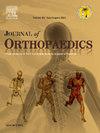Comparative outcomes of kinematically aligned TKA with medial stabilized design vs. mechanically aligned TKA with bi-cruciate stabilized design: A propensity score-matched analysis
IF 1.5
Q3 ORTHOPEDICS
引用次数: 0
Abstract
Purpose
Patient dissatisfaction after total knee arthroplasty (TKA) is often linked to altered knee kinematics and stability. This study compared the short-term clinical outcomes of kinematically aligned TKA (KA-TKA) and mechanically aligned TKA (MA-TKA) using bi-cruciate stabilized (BCS) implants.
Methods
In this propensity score-matched study, 60 patients who underwent either KA-TKA or MA-TKA (30 per group) with BCS implants were analyzed. Baseline characteristics, including age, sex, preoperative range of motion (ROM), and hip-knee-ankle alignment, were matched. ROM and clinical outcomes were evaluated preoperatively and at 1 year postoperatively using the 2011 Knee Society Score (KSS) subscales and Forgotten Joint Score-12 (FJS).
Results
At 1 year, the KA group achieved higher scores in KSS subscales for symptoms (23.2 vs. 20.0, p < 0.001), satisfaction (28.1 vs. 22.5, p < 0.001), functional activities (82.1 vs. 74.2, p = 0.011), and FJS (83.8 vs. 62.5, p < 0.001). No significant differences were observed in maximum extension, flexion, or KSS expectations.
Conclusions
KA-TKA demonstrated superior satisfaction and functional recovery than MA-TKA with BCS implants in the short term. These results suggested that KA-TKA, which reconstructs patient-specific alignment, may provide a more natural knee feel, leading to higher patient satisfaction compared to implant-driven BCS-TKA.
采用内侧稳定设计的运动学对齐TKA与采用双十字稳定设计的机械对齐TKA的比较结果:倾向评分匹配分析
目的全膝关节置换术(TKA)后患者的不满意通常与膝关节运动和稳定性的改变有关。本研究比较了使用双十字稳定(BCS)种植体的运动学对齐TKA (KA-TKA)和机械对齐TKA (MA-TKA)的短期临床结果。方法在这项倾向评分匹配的研究中,分析了60例使用BCS植入物进行KA-TKA或MA-TKA的患者(每组30例)。基线特征,包括年龄,性别,术前活动范围(ROM)和髋关节-膝关节-踝关节对齐,进行匹配。采用2011膝关节社会评分(KSS)亚量表和遗忘关节评分-12 (FJS)评估术前和术后1年的ROM和临床结果。结果1年后,KA组在KSS症状亚量表得分较高(23.2比20.0,p <;0.001),满意度(28.1 vs. 22.5, p <;0.001)、功能活动(82.1 vs. 74.2, p = 0.011)和FJS (83.8 vs. 62.5, p <;0.001)。在最大伸展、屈曲或KSS预期方面没有观察到显著差异。结论ka - tka短期内满意度和功能恢复优于MA-TKA联合BCS种植体。这些结果表明,与种植体驱动的BCS-TKA相比,重建患者特异性对齐的KA-TKA可能提供更自然的膝关节感觉,从而导致更高的患者满意度。
本文章由计算机程序翻译,如有差异,请以英文原文为准。
求助全文
约1分钟内获得全文
求助全文
来源期刊

Journal of orthopaedics
ORTHOPEDICS-
CiteScore
3.50
自引率
6.70%
发文量
202
审稿时长
56 days
期刊介绍:
Journal of Orthopaedics aims to be a leading journal in orthopaedics and contribute towards the improvement of quality of orthopedic health care. The journal publishes original research work and review articles related to different aspects of orthopaedics including Arthroplasty, Arthroscopy, Sports Medicine, Trauma, Spine and Spinal deformities, Pediatric orthopaedics, limb reconstruction procedures, hand surgery, and orthopaedic oncology. It also publishes articles on continuing education, health-related information, case reports and letters to the editor. It is requested to note that the journal has an international readership and all submissions should be aimed at specifying something about the setting in which the work was conducted. Authors must also provide any specific reasons for the research and also provide an elaborate description of the results.
 求助内容:
求助内容: 应助结果提醒方式:
应助结果提醒方式:


